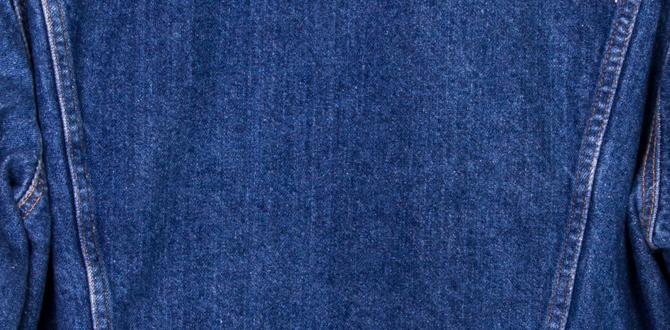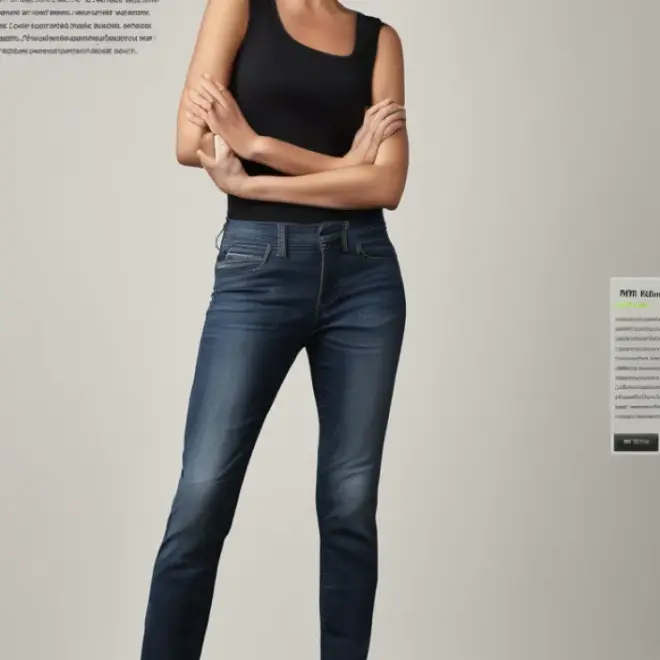Quick Summary: To hem flare jeans with borax, you’ll need fabric, scissors, measuring tape, pins, thread, a sewing machine, and optional borax for pre-treating. This guide clearly explains how to find your perfect length, prepare your jeans, and sew a neat hem, ensuring a professional finish even for beginners.
Having your favorite jeans just a little too long can be a common frustration. That classic flare, which looks so stylish, can sometimes drag on the floor, collecting dirt and looking unintentionally messy. The good news is that hemming flare jeans is a totally achievable DIY project, even if you’re new to sewing. With a few simple tools and this easy-to-follow guide, you can get that perfect pant length and keep your jeans looking sharp.
We’ll walk through everything you need to know, from figuring out your ideal jean length to the final stitch. You’ll feel confident in no time, and your flare jeans will fit like a dream. Let’s get started on making your wardrobe work better for you!
Why Hemming Flare Jeans Matters
Getting the length right on your flare jeans is more than just a style choice; it’s about practical wear and preserving your garments. Jeans that are too long can:
- Wear out faster: The excess fabric at the bottom can fray, snag, and develop holes from dragging on the ground.
- Look unkempt: Dragging hems can make even the most fashionable jeans appear messy.
- Cause tripping hazards: For some, the length issue can even be a safety concern.
Flare jeans, with their graduated width at the hem, present a slightly different challenge than straight-leg pants. The wider opening means you need to be precise to maintain the intended silhouette. But don’t worry, with the right technique, you can achieve a beautiful, even hem that complements the flare perfectly.
Understanding the “Borax” Element
You might be wondering about “Borax” in the title. In the context of hemming jeans, Borax (sodium tetraborate) is primarily used as a household cleaner and laundry booster. When it comes to hemming, its role is typically indirect. Some people use it as a pre-treatment for fabric to help with starching or to remove certain stains before sewing, which can make fabric easier to handle and sew. However, for standard hemming of pre-washed denim, it’s not an essential step and can be skipped. This guide will focus on the core hemming process, with a note where Borax might be considered, but it’s not a requirement for a successful hem. The key is proper measurement and sewing.
Gathering Your Supplies
Before you start cutting and sewing, make sure you have all the necessary tools. Having everything ready will make the process much smoother.
Essential Tools for Hemming
- Sewing Machine: While hand-sewing is possible, a sewing machine will give you a more durable and professional-looking stitch.
- Heavy-Duty Needles: Use needles designed for denim or heavy fabrics (size 90/14 or 100/16).
- Matching Thread: Choose a strong thread that matches the color of your jeans. Often, a slightly darker or lighter shade of golden-brown thread is used for a classic denim look.
- Fabric Scissors: Sharp scissors are crucial for a clean cut.
- Measuring Tape: For accurate length measurements.
- Fabric Chalk or Disappearing Ink Pen: To mark your cut line.
- Straight Pins: To hold the hem in place while you sew.
- Iron and Ironing Board: For pressing seams and hems flat.
- Seam Ripper (Optional but Recommended): If you need to remove the original hem for an authentic look.
- Borax (Optional): If you wish to try pre-treating the fabric as mentioned. Follow the manufacturer’s instructions for dilution and application if you choose to use it. For most denim hemming, this step can be omitted.
Step-by-Step: How to Hem Flare Jeans
This guide breaks down the process into simple, manageable steps. Remember to take your time, especially if this is your first time hemming.
Step 1: Determine Your Ideal Length
This is the most critical step. You don’t want to cut too much off! Here’s how to measure:
- Wear the Right Shoes: Put on the shoes you typically wear with your flare jeans. This is vital because the shoe height significantly impacts the required hem length.
- Put On Your Jeans: Wear the jeans you want to hem.
- Stand Naturally: Stand in front of a mirror, ensuring your weight is evenly distributed.
- Mark the Hem Point: You want the hem to just barely skim the top of your shoes, or land about 1/2 inch to 1 inch from the floor. Use your fabric chalk or pen to make a small mark on the outside seam and the inseam at the desired length. You can also use pins to mark the spot.
- Check All Sides: Walk around a bit to ensure the placement looks and feels right. You can make a second set of marks if needed.
Step 2: Prepare the Jeans for Cutting
Once you have your marked length, you need to prepare the jeans:
- Lay Flat: Lay your jeans flat on a large surface, like a table or the floor. Smooth out any wrinkles.
- Align Seams: Make sure the side seams and inseams are perfectly aligned. This is especially important for flare jeans, as an uneven seam can lead to an uneven hem.
- Mark Your Cut Line: Using your marked point as a guide, draw a straight line all the way around the leg with your fabric chalk or pen. Add your desired seam allowance below this line. For most hems, a 1-inch seam allowance is standard, but 1.5-2 inches is often better for flare jeans to maintain the shape and allow for a double-folded hem. This means you’ll be cutting below your desired finished length mark.
Step 3: Cut the Excess Fabric
Now it’s time to cut. Accuracy here prevents mistakes later.
- Cut Carefully: Using your sharp fabric scissors, carefully cut along the marked line. Try to make one continuous cut around the leg if possible.
- Check for Evenness: Once cut, check that both legs are the same length and that the cut is straight all the way around the hem. The wider opening of flare jeans can sometimes make it tricky to keep the cut even.
Step 4: Create the Hem (Double Fold Method)
The double fold hem is highly recommended for denim as it hides the raw edge and creates a clean, durable finish. This is where Borax could potentially be used, if you’re aiming to stiffen the fabric slightly for easier folding before ironing. Mix a small amount of Borax with water according to product instructions, lightly dampen the hem edge, and let it dry slightly before proceeding. Again, this is optional.
- First Fold: Take the raw edge of the fabric and fold it up towards the inside of the jean, by about 1/2 inch. Press this fold firmly with your iron. This encloses the raw edge.
- Second Fold: Once the first fold is pressed, fold the fabric up again, this time by 1 to 1.5 inches (depending on how much width you allowed for your seam allowance). This second fold creates the actual hem. Press this fold very well.
- Pin in Place: Use straight pins to secure the folded hem all the way around the leg. Place pins perpendicular to the fold, about every 2-3 inches. Ensure the pins go through all layers of fabric.
Step 5: Sewing the Hem
This is where your sewing machine comes into play. For a professional look, try to stitch as close to the inner folded edge as possible.
- Set Up Your Machine: Install a heavy-duty needle and thread. Set your stitch length to a medium setting (around 2.5mm).
- Start Sewing: Place the pinned hem under the presser foot, aligning the inner edge of the fold with your needle. Backstitch at the beginning to secure the thread.
- Sew Around: Carefully guide the fabric to sew a straight line around the entire hem. Go slowly, especially around the thick seams of your jeans. You may need to use your machine’s handwheel to ease over tough spots.
- Finishing the Stitch: When you reach where you started, backstitch a few stitches to secure the end.
- Trim Threads: Trim any excess threads.
Maintaining the Original Hem (Optional Advanced Technique)
For a truly authentic look, some people prefer to reattach the original factory hem. This is more complex and requires careful unpicking. If you’re a beginner, the double-fold method above is recommended.
If you choose this method:
- Carefully unpick the original hem stitches using a seam ripper.
- Press the original hem flat.
- Fold the new hem allowance to the inside, just enough to hide the raw edge.
- Pin the original hem back into place, aligning it perfectly with the original stitch line.
- Sew as close to the original stitch line as possible, using a matching thread.
This method requires patience and a good eye to replicate the factory finish. Resources like this guide from the National Agricultural Library, while about farmers markets, highlight the importance of detailed steps and preparation in any craft, a principle that applies here too.
Tips for Working with Denim
Denim can be tough, but a few tricks will make the process easier:
- Pre-wash Your Jeans: Always start with pre-washed jeans. This ensures they won’t shrink after you’ve hemmed them.
- Use a Denim Needle: This cannot be stressed enough. A standard needle will likely break or skip stitches.
- Go Slow: Especially around thick seams and the tapered part of the leg.
- Press as You Go: Ironing each fold before pinning and before sewing helps create crisp, sharp lines.
- Test Your Stitch: Before sewing on your actual jeans, practice on a scrap piece of denim to ensure your tension and stitch length are correct.
Troubleshooting Common Hemming Issues
Even with the best intentions, things can go wrong. Here are solutions to common problems:
Wavy Hem
Cause: Often caused by uneven feeding of fabric through the sewing machine or not pressing the folds adequately.
Solution: Try using a walking foot on your sewing machine, which helps feed layers of fabric evenly. For future hemming, press each fold very firmly.
Uneven Stitching
Cause: The fabric might be bunching up, or the machine tension is off.
Solution: Backstitch at the beginning and end. Sew slowly. Check your machine’s manual for adjusting thread tension. Always test on a scrap first.
Bunchey Seams
Cause: Trying to sew over multiple thick layers of denim seams.
Solution: Use your machine’s handwheel to manually lower the needle over the thickest part of the seam, giving you more control. You can also “step” over the seam by lifting the presser foot slightly (if your machine allows) and manually turning the wheel.
Hemming Techniques Compared
Here’s a quick look at common hemming methods and their suitability for flare jeans:
| Method | Description | Pros | Cons | Best for Flare Jeans? |
|---|---|---|---|---|
| Double Fold Hem | Folding the fabric edge twice to the inside and stitching. | Clean finish, hides raw edge, durable, beginner-friendly. | Adds a bit of bulk to the hem. | Yes – Excellent choice for a neat, durable hem that maintains the flare shape. |
| Single Fold Hem | Folding the fabric edge once and stitching. | Quicker, less bulky. | Raw edge is exposed (needs serging or hemming tape), may fray over time. | No – Not recommended for denim due to fraying potential. |
| Original Hem Reattachment | Carefully removing and re-sewing the original factory hem. | Most authentic look, preserves original distress. | Difficult, time-consuming, requires precision, might not be possible with heavily damaged original hems. | Yes, but advanced – For those seeking the original look and willing to put in the effort. |
| Hem Tape/Fusible Web | Using iron-on tape to secure the hemwithout stitching. | No-sew, fast. | Less durable, may not hold up to washing/wear, can create a stiff hem. | No – Generally not recommended for denim as it lacks durability and can look unprofessional. |
For flare jeans, the Double Fold Hem is your most reliable bet for a strong, clean, and attractive result without being overly complicated. For those aiming for the pinnacle of distressing and original look, reattaching the original hem is the way to go, though it demands more skill.
Frequently Asked Questions (FAQ)
Q1: How much fabric should I leave for a hem on flare jeans?
A1: For flare jeans, it’s best to leave about 1.5 to 2 inches of fabric for your seam allowance. This gives you enough to create a sturdy double-folded hem that will look good and last. You can always trim more if needed, but you can’t add it back!
Q2: Do I need a special sewing machine for denim?
A2: You don’t necessarily need a special sewing machine. However, you absolutely need a strong, reliable machine that can handle thick fabrics. Using the correct heavy-duty needle (for denim) and strong thread is crucial. Most standard mechanical or computerized machines can handle denim if they are in good working order and set up correctly.
Q3: How do I get my hem to look like the original factory hem?
A3: To achieve the most authentic look, you’ll need to carefully remove the original hem using a seam ripper, measure and mark your new hem length, cut the excess fabric, then re-stitch the original hem. This requires patience to match the original stitch line precisely. Many online tutorials focus specifically on this technique.
Q4: Can I hem flare jeans without a sewing machine?
A4: Yes, you can hem flare jeans without a sewing machine, but it will be more time-consuming and may not be as durable. You would use a strong hand-sewing stitch, like a backstitch or a whipstitch, to secure the folded hem. Ensure you make your stitches small and secure. For denim, a strong double-folded hem is still the best no-sew option.
Q5: Why are my jeans still too long after hemming?
A5: This usually happens if you didn’t account for the height of your shoes when measuring, or if the jeans stretched after washing and before hemming. Always measure with the shoes you’ll wear with them, and ensure your jeans are pre-washed and shrunk to their final size before you mark them for hemming. Taking a bit of extra fabric off the inseam rather than the outer seam can sometimes help adjust length subtly.
Q6: What’s the best way to mark a straight line on flare jeans?
A6: Lay the jeans perfectly flat and aligned on a smooth surface. Start by marking your desired finished length on the inseam and outseam (at their lowest points). Then, use a ruler or a flexible measuring tape held taut to draw a straight line connecting those points. Fabric chalk or a disappearing ink pen works best. Measuring from the waist down to the marked point at the side seam can also help ensure symmetry.
Conclusion
Hemming your flare jeans is a rewarding skill that allows you to achieve a perfect fit and extend the life of your favorite denim. By following these steps carefully, from precise measurement to neat sewing, you can confidently tackle this common clothing alteration. Remember to use the right tools, go slow, and press your seams well for a professional finish. Whether you’re aiming for a subtle adjustment or a complete transformation, mastering this technique will save you trips to the tailor and give you a fantastic sense of accomplishment. Your perfectly hemmed flare jeans are now ready to make a stylish statement!









